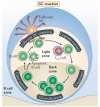Molecular programming of B cell memory
- PMID: 22158414
- PMCID: PMC3947622
- DOI: 10.1038/nri3128
Molecular programming of B cell memory
Abstract
The development of high-affinity B cell memory is regulated through three separable phases, each involving antigen recognition by specific B cells and cognate T helper cells. Initially, antigen-primed B cells require cognate T cell help to gain entry into the germinal centre pathway to memory. Once in the germinal centre, B cells with variant B cell receptors must access antigens and present them to germinal centre T helper cells to enter long-lived memory B cell compartments. Following antigen recall, memory B cells require T cell help to proliferate and differentiate into plasma cells. A recent surge of information - resulting from dynamic B cell imaging in vivo and the elucidation of T follicular helper cell programmes - has reshaped the conceptual landscape surrounding the generation of memory B cells. In this Review, we integrate this new information about each phase of antigen-specific B cell development to describe the newly unravelled molecular dynamics of memory B cell programming.
Figures





References
-
- Pape KA, Catron DM, Itano AA, Jenkins MK. The humoral immune response is initiated in lymph nodes by B cells that acquire soluble antigen directly in the follicles. Immunity. 2007;26:491–502. - PubMed
-
- Qi H, Egen JG, Huang AY, Germain RN. Extrafollicular activation of lymph node B cells by antigen-bearing dendritic cells. Science. 2006;312:1672–1676. - PubMed
-
- Batista FD, Harwood NE. The who, how and where of antigen presentation to B cells. Nature Rev. Immunol. 2009;9:15–27. - PubMed
-
- Carrasco YR, Batista FD. B cells acquire particulate antigen in a macrophage-rich area at the boundary between the follicle and the subcapsular sinus of the lymph node. Immunity. 2007;27:160–171. - PubMed
Publication types
MeSH terms
Substances
Grants and funding
LinkOut - more resources
Full Text Sources
Other Literature Sources
Molecular Biology Databases

